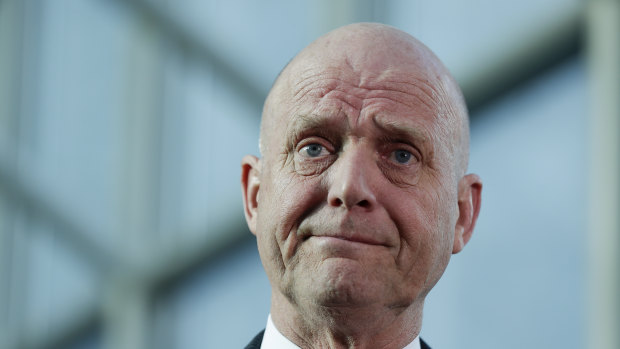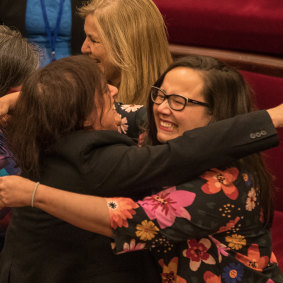This was published 5 years ago
Opinion
We need to consider what assisted dying legislation promised
By Mark Green
As the ACT government was on the brink of industriously progressing its bid for its own physician-assisted suicide regime, interested parties - albeit few, and fully aware of the outcome - watched closely as the Australian Senate debated whether to allow the ACT and Northern Territory to make physician-assisted suicide law.
There were those who strongly and probably rightly asserted that the territories should have the right to govern and legislate in equal measure to their cousin states. Most people would concede that to be fair. But we need to remember that it wasn't the rights of governments to legislate what is up for debate in Canberra — what was on the table was the right for the ACT and NT governments to legislate and by extension facilitate a person’s medically-assisted suicide in the case the desire to suicide is voiced.

Senator David Leyonhjelm's bill to restore territory rights to make laws on euthanasia was defeated after two days of debate.Credit: Alex Ellinghausen
No matter how you cut it, any person requesting help to terminate their life is an especially vulnerable human being. How we address the needs and directly related desires of this cohort attracts a more divided response. So how has it come to this – and why now? Why in 2017/18 have we garnered the perfect confidence to instigate and execute within a period of months such seismic shifts in our social and moral fabric?
Are we suddenly and consummately getting everyone’s health, aged and psychiatric care right, 100 per cent of the time? Have we arrived at a place where our doctors might find it acceptable to ignore what seemed to be the insuperable Hippocratic order to do no harm, a value that until now has guided the medical profession in Australia and everywhere else from the start?
Why did the Senate vote come at a time when the ACT’s Select Committee on End of Life Choices was being inundated with troubling evidence of gross inadequacies in palliative and end-of-life care funding, accessibility and diversity of service delivery? And at a time when Canberra Hospital is navigating serious accreditation challenges; and when just last month it was reported that ACT mental health providers were struggling to keep and attract the expert staff needed to meet growing and desperate demand.
Surely there are other things, other areas formed on the principles of compassionate and genuine care that require immediate and dedicated work.
Perhaps more concerning is the looming and serious potential to set back some of the fragile confidence in the government’s sincerity for the nurturing and growth of a vibrant First Peoples. The Northern Territory is home to more than 58,000 First Australians. A population that is already 2.6 times more likely to suicide than the rest of us. When the Senate gathered in Parliament House in Canberra on Tuesday, they were 3950kms from Darwin - that’s more than a few thousand kilometres from Aboriginal and Torres Strait Islander communities that have been struggling with all manner of setbacks - every kind of abuse, substance addiction, mental health concern and the suicides that result from a broad and complex range of suffering - for generations. What message does the Commonwealth stand to send loud and clear north when it undermines its investments in Indigenous suicide prevention?
Surely we’ve come too far to not understand the impact a government’s laws and policies has on the way members of vulnerable populations view themselves and make decisions.
But few of these concerns are new. We’ve seen how the debates have gone in New South Wales and Victoria – the latter a gut-wrenching marathon, ultimately successful in pushing its passage of reform in November. We saw the leveraging of horror stories ascribed to those who have experienced a hard death and voiced by others who have accompanied them calling for compassion and grasping for better alternatives while navigating their own depths of grief. Emotional late night debates in both states made apparent the fears and anxieties of even our brightest and most enlightened representatives – attributed to the unknown, uncontrollable and the unthinkable surrender to our mortality that at the most inexcusable points in life firmly wedges its foot in the doorway and demands everybody take notice.
Until now, the time of our death hasn’t been a choice. But ultimately the people want choice, and their politicians will give it to them.

Members of the Victorian Upper house celebrate with hugs and tears of joy after a marathon 29 hours sitting to pass the Voluntary Assisted Dying Bill in November 2017. Credit: Jason South
Deafening calls for reform originate with the well, the educated and the financially secure. Less resolute are the people living in our aged care facilities and retirement communities, homeless people, prisoners, children and young adults, CALD Australians, our First Peoples and people struggling with mental illness and dementia; people living with physical disability and those carrying the cultural and personal trauma that follows abuse. Society’s acceptance of assisted dying and its inevitable passage into the norm will challenge how these people measure the value of their lives. Victoria has done the avant-garde work, passing its Voluntary Assisted Dying Bill last year. But the regime is yet to be rolled out and non-existent Australian data on Victoria’s great experiment cannot yet be analysed. What are the gaps in safeguards that will need to be plugged, naturally unapparent today but soon to be obvious and regrettable? Will the lethal drug administered avoid issues reported overseas, including patient seizures, regaining consciousness and prolonged death of up to four days? How many instances of abuse and coercion in an assortment of ways and types will be exposed in the media before public outrage demands a tightening of regulation is anyone’s guess, but still assured and assured to be regrettable when it occurs.
The Victorian system remains untested. Oregon on the other hand, in the United States, has been doing assisted suicide for just more than 20 years. Linda Ganzini and colleagues in a study from 2000 looked at the reasons why people already euthanised had requested their lives be terminated – an important question for our legislators to consider. Physical pain was cited as a motivator in 43 per cent of cases, as we’d all expect, but perhaps other reasons may come as a surprise. Things like poor quality of life (55 per cent), viewing themselves as a burden (38 per cent) and seeing continued existence as pointless (47 per cent) were all reasons accepted in people’s bid to be medically assisted to die.
The leading reason to pursue assisted suicide in Oregon was loss of independence, not physical pain – a motivator in 57 per cent of cases. It’s in no way doubtful that similar concerns are felt here in Australia. It’s how we respond to these concerns that is bringing us closer to the Oregon solution.
The big challenge, as it has always been, will be to find ways to address the real and often difficult to determine reasons for seeking an assisted death. Dying is tough, there’s no question about that. Tougher still may be confronting just how we’re allowing ourselves to be distracted from improving and expanding critical services in pursuit of the false promise of a clean, easy and attractively controllable life-ending alternative to ‘dying’.
Mark Green is Calvary Hospital's National Director of Mission and National Chief Executive Officer. (Acting).